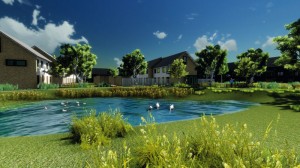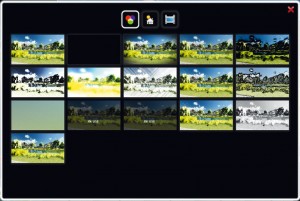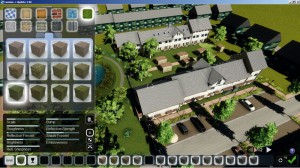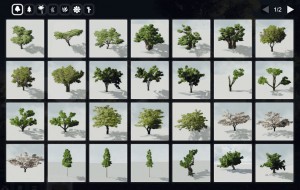Why you can trust Creative Bloq

- Price: £640 / $980 / €749
- Developer: Act-3D
- Platform: Windows
Main features:
- Real-time scene creation and population
- Import of various 3D file formats
- Contains a vast content library
- Output to animations and stills in various resolutions
- Theatre mode for live demonstrations
Act-3D, the developer of Quest3D, has launched a new tool called Lumion, aimed at architects who want an easy-to-use animation and presentation program.
You can import a 3D model, materialise and populate the scene, then output it to animations or stills. We haven’t seen any other software that does the same thing as Lumion with such a gentle learning curve.
We tested the software on an Nvidia GTS 350M, which is a little slower than the minimum requirements, but performance was still pretty good.
Lumion uses the GPU for the user interface, editing and rendering, so it’s recommended that you buy the fastest GPU your budget allows.
After starting up Lumion, you have a few options: you can start a new scene, load an example scene, open an existing scene or go to the tutorial website.

If you start a new scene, you can choose from nine different environments, which are a good starting point for most of the world’s scenery.
You can easily add mountains or water surfaces and change the ground texture to fine-tune the look.
For sky and lighting conditions, Lumion comes with a weather system. The basic system enables you to adjust fog depth, sun direction, sun height and cloudiness. Cloudiness controls the density of the clouds and lets you make the sky either clear or overcast – although the cloud formation (pattern) can’t be changed.
In the advanced weather system, you can alter light (sun, sky and shadow lighting/colouring), effects (screen space ambient occlusion and wind strength), camera settings (exposure, focal length and so on) and fog/cloud settings.
Easy imports
Importing an object into the environment is as easy as it gets. Lumion supports most popular 3D file formats, such as COLLADA, FBX, MAX, 3DS, OBJ and DXF. If you want to import MAX files, you need to have a working version of 3ds Max on the same system.
The imported model will be put in your own model library inside Lumion and can be placed by dragging and dropping it in your environment.
If you don’t like the existing materials on the imported model, or some areas don’t have any, it’s easy to select different parts and start materialising them.

Lumion comes with over 450 preset materials and you can also make your own by using a custom shader. These shaders enable you to start your creations from scratch and the various properties, such as bump value, Fresnel values, reflection strength and sharpness, let you create pretty realistic looking materials.
Be careful if you change materials or make any other alterations, though, because you can only undo one step for many major functions.
To enhance the environment and make the final presentation look real, you can populate it with trees, people, cars, generic buildings, street furniture and so on from the content library that comes with Lumion.
Simply drag and drop the content into your scene and then move and rotate it to the correct position – unfortunately, there’s no scaling option.
As content is one of the most important features, customers can expect a large initial library and regular upgrades and/or service packs that will expand it even further.
There are two ways of outputting the presentation: stills or animation. For stills, you can choose between four formats with a maximum resolution of 7,680x4,320, while animations can be outputted in three formats up to 1,080 full HD, either as an image sequence or MP4 movie.
You can build up your project by animating the camera, the objects and the weather system, and adding post effects.
Camera animation is done by interactively manoeuvring to a position in your scene and taking a snapshot of the view. Go to the next position and take a snapshot there, and Lumion will make an animation path between those two points. This is an easy process, and also enables you to alter or fine-tune the animation afterwards.
Working with objects

Animating objects is done in two ways: either you place pre-animated objects or you animate the movement of objects in the movie section of Lumion. There are a lot of pre-animated objects in the library, such as flying birds, grazing cows and so on.
The high-quality trees and plants (from Speedtree) have wind animation on them too.
Animating movement of cars, people or any other object is always done in one direction with one speed, which means you can’t move cars up and down, or let people walk in a curve. Also, importing animated objects isn’t supported.
Animating the weather system, on the other hand, can be done in almost every way. By animating the clouds, fog distance, sun colour or bloom, for instance, you can really control the final result.
To finish the look, you can add various post effects; use a colour correction to adjust the brightness and contrast or add motion blur and anti-aliasing.
There are also a few Photoshop-like filters, such as Charcoal, Pencil and Sobel.
One thing that stands out is that there’s no output into an interactive standalone presentation format. Since Act-3D has lots of experience with this from Quest3D, this will hopefully be fixed in a future update.
Lumion is already an impressive piece of software, but there are still a few important areas that need development.
Importing models, materialising them and populating the scene is a piece of cake, while animating objects is limited. Given the gentle learning curve, vast content library and controllable look and feel of the result, Lumion is good value for money.
This is a tool that could easily be incorporated into the pipeline of many architects in the near future, though we’re not sure that the software will find its way into other fields because it seems to be really specialised towards that market.
Overall, however, we were pleasantly surprised by Lumion.
Verdict
Lumion does still need a little work, but Act-3D’s software is already a valuable addition to the architect’s pipeline. With this tool, you’ll be able to create more convincing presentations in less time than you could before.
PROS
• Very easy to learn
• Large content library
• Balance of quality versus speed
CONS
• Restricted object animation
• No interactive standalone output
• Very limited undo functionality

Thank you for reading 5 articles this month* Join now for unlimited access
Enjoy your first month for just £1 / $1 / €1
*Read 5 free articles per month without a subscription

Join now for unlimited access
Try first month for just £1 / $1 / €1

The Creative Bloq team is made up of a group of art and design enthusiasts, and has changed and evolved since Creative Bloq began back in 2012. The current website team consists of eight full-time members of staff: Editor Georgia Coggan, Deputy Editor Rosie Hilder, Ecommerce Editor Beren Neale, Senior News Editor Daniel Piper, Editor, Digital Art and 3D Ian Dean, Tech Reviews Editor Erlingur Einarsson, Ecommerce Writer Beth Nicholls and Staff Writer Natalie Fear, as well as a roster of freelancers from around the world. The ImagineFX magazine team also pitch in, ensuring that content from leading digital art publication ImagineFX is represented on Creative Bloq.
